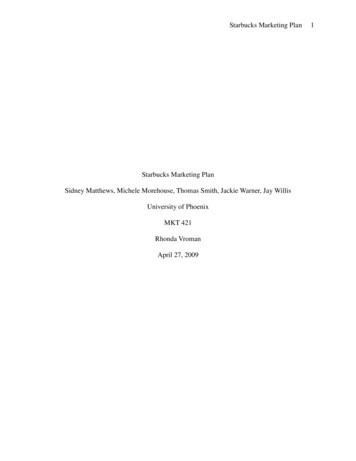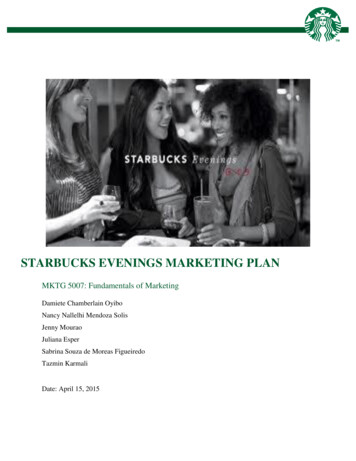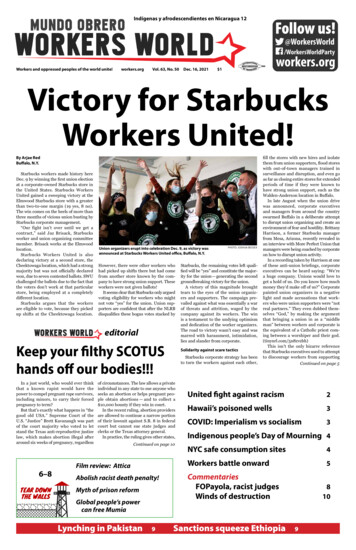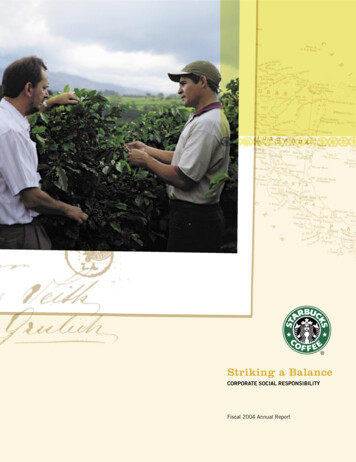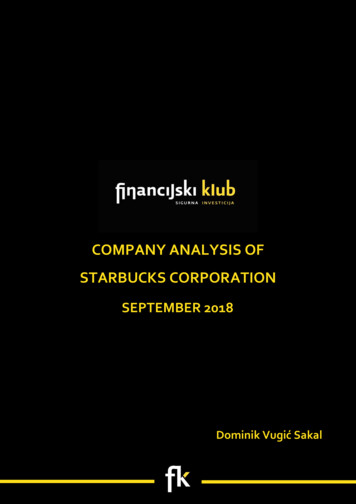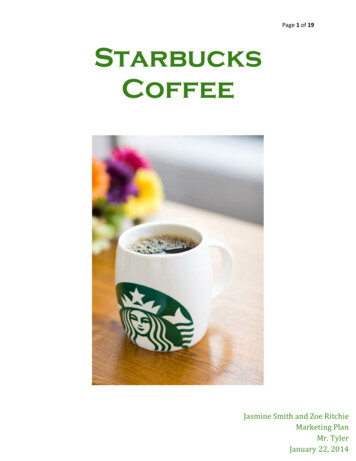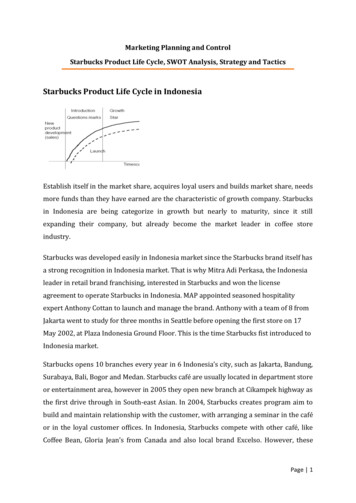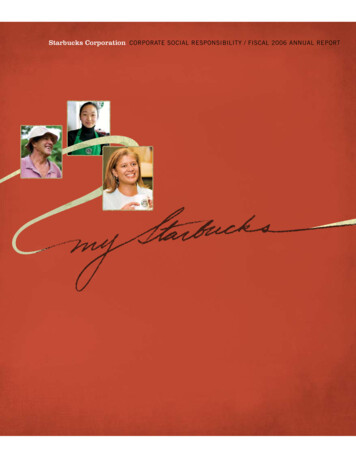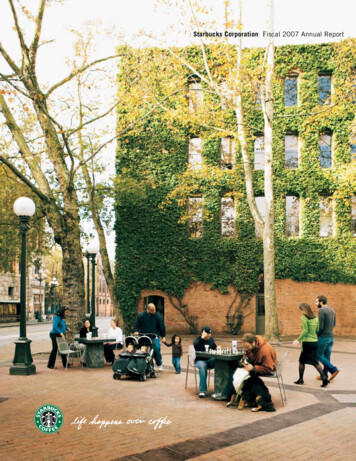
Transcription
Embedding Food Safety in Starbucks China’s Culture & StrategyEMBEDDING FOOD SAFETY IN STARBUCKS CHINA’SCULTURE AND STRATEGYStarbucks China is the first major food retail chain to be FSSC 22000 certified. With catering beinga relatively new scope for FSSC 22000, Starbucks has shared its learnings from the FSSC 22000certification process to inspire and help other catering organizations elevate their food safety andquality standards. Linda Zhang (Vice President, Product Innovation, Food Safety, Quality &Regulatory of Starbucks China and AP) and Stam Yang (Vice President, Food Safety & Quality ofStarbucks China) present Starbucks China’s approach to food safety.FSSC 22000FSSC 22000LindaSTARBUCKS CHINA: ‘GOLD STANDARD’ VISIONSince entering the Chinese mainland market more than 20 years ago, food safety has always beena key element in Starbucks’ strategy. This is reflected in Starbucks aspiration to achieve acomprehensive ‘Gold Standard’ for food safety that leads the industry in China. In 2016, StarbucksFSSC 22000 Version 5 August 20203 September 20200 of 4
Embedding Food Safety in Starbucks China’s Culture & StrategyChina started researching into food safety management systems, eventually making the decisionto adopt FSSC 22000.2016FSSC 22000Linda explained, “The framework for Starbucks Gold Standard in food safety consists of eightelements. One of these is running an excellent and advanced food safety management system. Inorder to set a benchmark, we conducted thorough research on existing standards in the food andbeverage industry. There were three deciding factors that made us choose FSSC 22000.”LindaFSSC 22000“Firstly, we wanted a Food Safety Management System certification that is recognized by the GlobalFood Safety Initiative, so that we are benchmarking ourselves to leading global standards.Secondly, FSSC 22000 has its roots in food manufacturing in contrast to other retail based foodsafety management systems, which is a better fit for our business. Finally, FSSC 22000 uses a riskbased approach which helps to make our approach towards food safety more thoughtful andsystematic, based on an evaluation of the risks existing in our activities.”GFSIFSSC 22000FSSC 22000“QUARTER OF QUALITY” PROGRAMWith over 50,000 partners (employees) working across over 4.400 stores in China, Food SafetyCulture is of utmost importance to Starbucks food safety strategy. Stam explains how it isembedded in every Starbucks store, “We have a diverse portfolio of stores, operated by differentpartners in different environments. Every partner in every store has to take responsibility inensuring food safety. Therefore, we have to work hard to create a sense of ownership on foodsafety within our culture.”4400Stam3 September 20201 of 4
Embedding Food Safety in Starbucks China’s Culture & Strategy“An example of how Starbucks engages our partners on food safety is our ‘Quarter of Quality’program. We run this Food Safety and Quality campaign every year since 2014, with the purposeof engaging all partners on the topic in a fun and engaging way, to make sure it is top of mind forour partners. During the campaign, we leverage our internal social media platform to runinteractive quizzes to refresh partners’ knowledge. Furthermore, we organize competitions wherepartners can share their best practices, and even show their artistic flair by designing their ownsymbol for food safety.”2014FOOD SAFETY DURING A GLOBAL PANDEMIC: COVID-19(COVID-19)During the COVID-19 pandemic, companies faced lots of challenges. For Starbucks some of thosechallenges led to holistic rethinking and changes of its ways of working, which helped to enhancethe company’s effectiveness and efficiency.COVID-193 September 20202 of 4
Embedding Food Safety in Starbucks China’s Culture & Strategy“During the pandemic, we closed some of our stores. Demand shifted towards digital ordering anddelivery. Starbucks China created contactless experience to embrace the changes in consumerbehavior. This entailed a thorough review of the risks and our approach to food safety in theseareas,” according to Linda.Linda“Another challenge was that we couldn’t perform audits of our supplier and production processesduring the lock down. That drove us to explore creative solutions using virtual technology andartificial intelligence, such as joining audits through digital video devices in our supplier plants.”“We also changed how we trained our partners. We were used to giving food safety training to ourpartners in-person in the stores. With the pandemic, we ran trainings via a streaming serviceinstead. It is a more efficient approach and our broadcasts have been well received. As thesessions were recorded, our partners can also view them again when needed.”LEARNINGS FROM THE FSSC 22000 CERTIFICATIONPROCESSFSSC 22000Overall there are three important lessons that Starbucks China has learned and implementedfrom the FSSC 22000 certification process:FSSC 220001. SYSTEMATIC MANAGEMENT1.One of the main reasons for Starbucks China striving for FSSC 22000 certification was to establisha standardized food safety management system. This systematic approach has helped Starbucksto connect the dots and create one integrated approach.FSSC 220003 September 20203 of 4
Embedding Food Safety in Starbucks China’s Culture & Strategy2. RISK BASED APPROACH2.The second learning is adopting a risk based approach towards food safety. As Linda explained,“Starbucks is in the process of implementing food safety assessment for all stores around theglobe. We noticed that audits based on performance scores help us identify hidden food safetyrisks. Another new element is the ‘self-check approach’: store partners need to perform their ownself-assessments, which motivates them to take up more ownership and commitment in ensuringfood safety.”Linda3. FOOD SAFETY BY DESIGN3.“We have incorporated the risk based model into our design processes. When we design a newstore or a new product, one of the lead questions is ‘How do we ensure food safety?’. This way,food safety is embedded in all our processes right from the very beginning.”END3 September 20204 of 4
program. We run this Food Safety and Quality campaign every year since 2014, with the purpose of engaging all partners on the topic in a fun and engaging way, to make sure it is top of mind for our partners. During the campaign, we leverage our internal social media platform to run interactive quizzes to refresh partners' knowledge.
